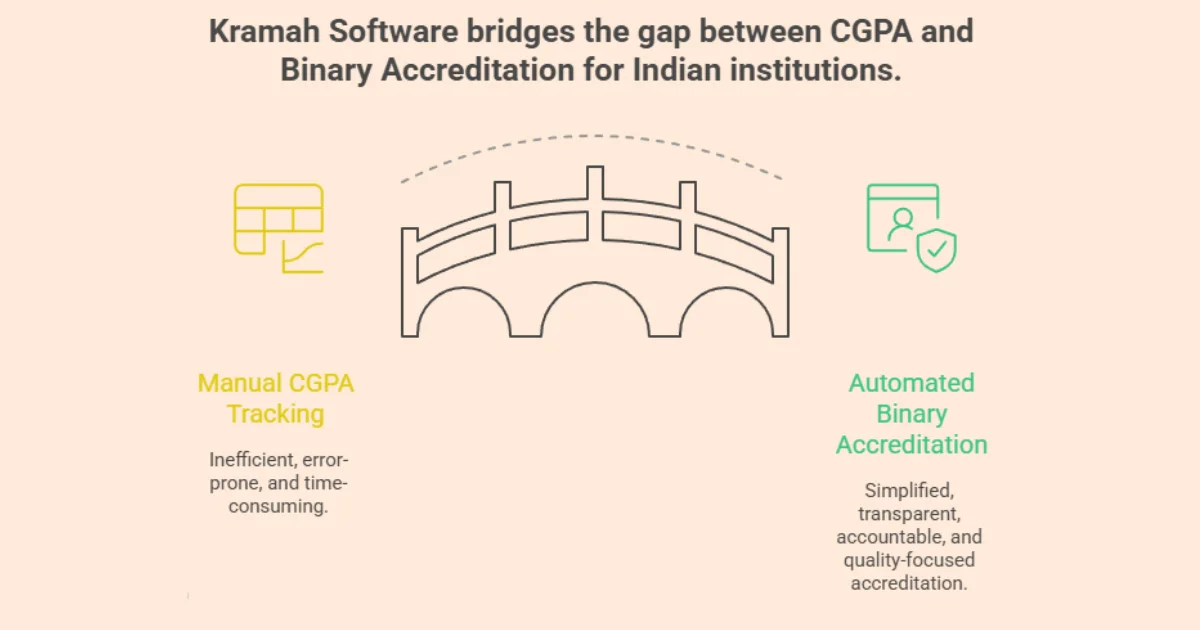Comparing NAAC Grading System vs NAAC Binary System
Explore the shift from the NAAC grading system to the new NAAC binary accreditation. Learn key differences, benefits, and how institutions should adapt in 2025.
By, Shashank Chouhan

NAAC replaced its old CGPA-based NAAC grading system which graded institutions from A++ to D, with a Binary Accreditation System, where institutions will be evaluated on a simple Yes/No compliance framework. For many institutions, this change feels like a turning point: Will the new framework raise the bar for quality, or will it simplify compliance?
Understanding the detailed differences helps colleges prepare better and avoid pitfalls.
Old NAAC Grading System with CGPA
In the NAAC Grading System, institutions were graded using a Cumulative Grade Point Average (CGPA). Based on their score, they were placed into categories like:
- • A++ (highest)
- • A+, A
- • B++, B+, B
- • C
- • D (Not Accredited)
This system gave institutions a rank but also created challenges:
- Complexity: Multiple grades were hard to interpret for students and the public.
- Subjectivity: Some criteria left room for interpretation.
- Focus on score, not process: Institutions sometimes aimed for a higher grade rather than improving practices.
Criteria of the NAAC Grading System
The CGPA-based accreditation focused on weighted scores across 7 criteria:
- NAAC Criteria 1: Curricular aspects
- NAAC Criteria 2: Teaching-learning and evaluation
- NAAC Criteria 3: Research, innovation, and extension
- NAAC Criteria 4: Infrastructure and learning resources
- NAAC Criteria 5: Student support and progression
- NAAC Criteria 6: Governance, leadership, and management
- NAAC Criteria 7: Institutional values and best practices
Key characteristics of NAAC Grading System:
- Scores ranged from A++ (highest) to D (lowest).
- Evaluation was semi-subjective, depending on assessor interpretation.
- Documentation was often manual, and field visits were common.
- Continuous readiness was less critical; many colleges focused only on pre-inspection submission.
New NAAC Binary System
The new system does away with grades. Instead, institutions now receive a clear result:
- Accredited
- Not Accredited
The evaluation is based on Yes/No responses across 10 key attributes,
such as Curricular Aspects, Teaching-Learning and Evaluation, Research and Extension, Infrastructure and Learning Resources, Student Support and Progression, Governance, Leadership, and Management, Institutional Values and Best Practices, Innovation and Best Practices, Sustainability and Environmental Impact, and Community Engagement & Outreach
If an institution meets the required standards, it is accredited. If not, it is not accredited. (NAAC Binary Accreditation Explained in Detail here)
Authority note: According to NAAC’s official 2024 guidelines, the Binary Accreditation is designed to “reduce subjectivity and ensure accountability”
Detailed Comparison: NAAC Old vs NAAC New Framework
Aspect | NAAC Grading System | NAAC Binary Accreditation |
|---|---|---|
| Grading | A++ to D | Accredited / Not Accredited |
| Metrics | 7 criteria | 10 key attributes |
| Evaluation | Weighted & semi-subjective | Objective, Yes/No compliance |
| Audit & Verification | Field visits common | AI-assisted digital checks possible |
| Documentation | Manual spreadsheets | Centralized, automated digital repository |
| Continuous Readiness | Optional | Essential year-round |
| Outcome Focus | CGPA score focus | Student and institutional outcomes emphasized |
| Automation | Minimal | Required for accuracy and efficiency |
| Stakeholder Role | Limited | Active involvement of faculty, staff, and students |
| Global Alignment | Moderate | High; aligns with international binary/ checklist frameworks |
Beyond Binary: Maturity-Based Graded Levels (MBGL)
While the binary system simplifies accreditation, NAAC also introduced MBGL (Maturity-Based Graded Levels) for institutions that want to showcase growth beyond compliance.
Level 1: Basic
Level 2: Developing
Level 3: Established
Level 4: Advanced
Level 5: Global Excellence
This allows institutions to still demonstrate progress over time, but only after they first meet the binary accreditation standards.
Implications for Colleges
Switching from NAAC Grading System to Binary Accreditation affects:
- Documentation & Compliance: Missing evidence now directly affects accreditation status.
- Digital Readiness: Manual processes are no longer sufficient; institutions must use digital tools.
- Continuous Improvement: Year-round monitoring ensures better compliance and avoids last-minute errors.
- Stakeholder Engagement: Faculty and administrators must understand the 10 key attributes and their evidence requirements.

How Kramah Software Supports Both Systems
While the CGPA system required manual tracking and spreadsheets, Kramah KI-NAAC Software now:
- Maps documents to binary metrics automatically
- Tracks compliance in real-time dashboards
- Generates AQAR, SSR, and binary reports with one-time data entry
- Sends alerts and notifications to faculty for missing documents
- Enables audit-ready digital submissions
Kramah Software ensures a smooth transition for institutions moving from the old system to the new binary model.
Conclusion
The shift from the CGPA-Based NAAC grading system to Binary Accreditation is a big change for Indian higher education. It simplifies evaluation, improves transparency, and reduces pressure to chase grades. With MBGL, institutions can still highlight their maturity and long-term growth.
The new system ensures that accreditation is no longer about competition; it’s about accountability and quality.
Summary
The NAAC Binary Accreditation system (2024) replaces CGPA grades with a simple Accredited/Not Accredited status. It introduces 10 key attributes, objective assessments, and digital workflows. Institutions must adapt to stricter compliance, evidence-based evaluation, and continuous improvement. MBGL offers further classification into five maturity levels.
